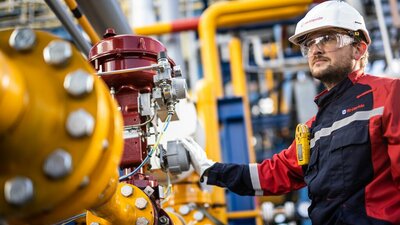PEM electrolyzers to produce renewable hydrogen: how does it work?
Published on May 28, 2024
2 minutes

Did you know that one way of producing renewable hydrogen, with a minimal carbon footprint, is to separate water molecules using renewable electricity? The molecules are separated by means of water electrolysis. Air Liquide produces renewable hydrogen on a large scale. Watch our video on how proton exchange membrane (PEM) electrolyzers work.
PEM electrolyzers use electricity to split water molecules into hydrogen and oxygen by means of electrolysis. This technological process occurs in an electrolyzer made up of individual PEM cells that are stacked one on top of the other. Within each cell, a proton-conducting polymer membrane physically separates the hydrogen and oxygen. When the current is turned on, the water molecules dissociate: the protons cross the membrane and are transformed into hydrogen gas, while the oxygen is removed separately.
With its highly reactive polymer membrane, PEM electrolyzer technology has the major advantage of being able to adapt quickly to variations in the production of intermittent renewable electricity, such as hydro, wind and solar power. In just a few seconds, they can go from operating at full power to completely shutting down, depending on changes in energy supply! This is an invaluable advantage when it comes to producing renewable hydrogen from intermittent energy sources as part of a process that is local, sustainable and low-carbon.
Air Liquide has committed to developing renewable hydrogen by 2030 and PEM electrolyzer technology has a key role to play in meeting this objective. For instance, Air Liquide already produces more than 8 tons of renewable hydrogen every day using this technology on its Bécancour site in Canada. In addition, the Group is in the process of building the world’s largest PEM electrolyzer, with a capacity of 200 MW, in Port-Jérôme in France. In collaboration with Siemens Energy, Air Liquide also inaugurated in 2023 a gigafactory to produce PEM modules in Berlin and is finalizing the Trailblazer project, a PEM electrolyzer with a capacity of 20 MW located in Oberhausen, Germany. Thanks to these projects, Air Liquide is further contributing to the transition to a low-carbon society.


